Revegetation of Thermal Power Plant Ash Dumps or Sustainable Urban Development
Abstract
1. Introduction
2. Materials and Methods
2.1. Study Object
2.2. Plants for Revegetation
2.3. Methods
3. Results and Discussion
4. Conclusions
Author Contributions
Funding
Institutional Review Board Statement
Informed Consent Statement
Data Availability Statement
Conflicts of Interest
References
- Sustainable Development GOALS. Available online: https://www.un.org/sustainabledevelopment/development-agenda (accessed on 14 October 2024).
- Transforming Our World: The 2030 Agenda for Sustainable Development A/RES/70/1. United Nations. 41p. Sustaina. Available online: https://undocs.org/en/A/RES/70/1 (accessed on 14 October 2024).
- Shulga, J. Sustainable Development: What Is It and Why Is It Important? Forbes. Available online: https://www.forbes.ru/obshchestvo/425081-ustoychivoe-razvitie-chto-eto-takoe-i-v-chem-ego-znachimost (accessed on 14 October 2024).
- Statista. Available online: https://www.statista.com/statistics/859266/number-of-coal-power-plants-by-country (accessed on 14 October 2024).
- SMS-IT. Available online: https://www.sms-it.ru/2015/02/blog-post.html (accessed on 14 October 2024).
- VEDOMOSTI. Available online: https://www.vedomosti.ru/business/articles/2023/08/25/991818-v-rossii-k-2050-godu-dolya-uglya-v-generatsii-energii-mozhet-virasti (accessed on 14 October 2024).
- Minh, V.T.N.; Pham, V.-H.; Tung, V.H.; Tung, C.T.; Phuong, N.T.H. Firing-associated Recycling of Coal-fired Power Plant Fly Ash. J. Anal. Methods Chem. 2023, 2023, 8597376. [Google Scholar] [CrossRef]
- Vilakazi, A.Q.; Ndlovu, S.; Chipise, L.; Shemi, A. The Recycling of Coal Fly Ash: A Review on Sustainable Developments and Economic Considerations. Sustainability 2022, 14, 1958. [Google Scholar] [CrossRef]
- Kosivtsov, Y.Y.; Chalov, K.; Sulman, M.G.; Lugovoy, Y.; Novichenkova, T.; Petropavlovskaya, V.; Gadzhiev, S.; Popel, O. Use of Ash and Slag Waste from Thermal Power Plants as an Active Component of Building Materials. Chem. Eng. Trans. 2021, 88, 337–342. [Google Scholar] [CrossRef]
- Nayak, D.K.; Abhilash, P.P.; Singh, R.; Kumar, R.; Kumar, V. Fly Ash for Sustainable Construction: A Review of Fly Ash Concrete and Its Beneficial Use Case Studies. Clean. Mater. 2022, 6, 100143. [Google Scholar] [CrossRef]
- Lv, R.; Liang, S.; Li, X.; Hou, H.; Ke, Y.; Li, X.; Tang, M.; Quan, J.; Yuan, S.; Hu, J.; et al. Production of Water-permeable Ceramic Bricks Derived from Fly Ash Via a Simple Pellet Method: Mechanism of Mechanical Strength and Permeability. Constr. Build. Mater. 2022, 351, 128989. [Google Scholar] [CrossRef]
- Húlan, T.; Štubna, I.; Ondruška, J.; Trník, A. The Influence of Fly Ash on Mechanical Properties of Clay-Based Ceramics. Minerals 2020, 10, 930. [Google Scholar] [CrossRef]
- Hoa, N.V.; Thuy, N.B.T.; Anh, N.L. Application of Waste Fly Ash in Roadbed Construction. IJERT 2023, 12. [Google Scholar] [CrossRef]
- Woszuk, A.; Bandura, L.; Franus, W. Fly Ash As Low Cost and Environmentally Friendly Filler and Its Effect on the Properties of Mix Asphalt. J. Clean. Prod. 2019, 235, 493–502. [Google Scholar] [CrossRef]
- Pedro, M.P.S.; Samuel, C.M.; Mercedes, D.G.C.; Irina, D.R.; Guillermo, R.G.C. Use of Fly Ash in the Production of Geopolymers: A Literature Review. Innov. Infrastruct. Solut. 2022, 7, 236. [Google Scholar] [CrossRef]
- Luhar, I.; Luhar, S. A Comprehensive Review on Fly Ash-Based Geopolymer. J. Compos. Sci. 2022, 6, 219. [Google Scholar] [CrossRef]
- Hussain, A.; Ali, J.; Faizan, S. Exploring the Scientific Research on Coal Fly Ash and Agriculture: Knowledge Mapping and Future Research Directions. Environ. Sci. Pollut. Res. Int. 2023, 30, 121292–121305. [Google Scholar] [CrossRef] [PubMed]
- Dhadse, S. Utilization of Fly Ash in Agriculture: Perspectives and Challenges. J. Mater. Environ. Sci. 2024, 15, 1038–1050. [Google Scholar]
- Thomas, B.S.; Dimitriadis, P.; Kundu, C.; Vuppaladadiyam, S.S.V.; Raman, R.K.S.; Bhattacharya, S. Extraction and Separation of Rare Earth Elements from Coal and Coal Fly Ash: A Review on Fundamental Understanding and On-going Engineering Advancements. J. Environ. Chem. Eng. 2024, 12, 112769. [Google Scholar] [CrossRef]
- Fuks, L.; Miśkiewicz, A.; Herdzik-Koniecko, I.; Zakrzewska-Kołtuniewicz, G. Fly Ash as a Potential Adsorbent for Removing Radionuclides from Aqueous Solutions in an Adsorption-Membrane Assisted Process Compared to Batch Adsorption. Membranes 2023, 13, 572. [Google Scholar] [CrossRef]
- Yadav, V.K.; Modi, T.; Alyami, A.Y.; Gacem, A.; Choudhary, N.; Yadav, K.K.; Invati, G.K.; Wanale, S.G.; Abbas, M.; Ji, M.-K.; et al. Emerging Trends in the Recovery of Ferrospheres and Plerospheres from Coal Fly Ash Waste and Their Emerging Applications in Environmental Cleanup. Front. Earth Sci. 2023, 11, 1160448. [Google Scholar] [CrossRef]
- Vig, N.; Ravindra, K.; Mor, S. Environmental Impacts of Indian Coal Thermal Power Plants and Associated Human Health Risk to the Nearby Residential Communities: A Potential Review. Chemosphere 2023, 341, 140103. [Google Scholar] [CrossRef] [PubMed]
- Sahu, R.; Patil, G.; Dubey, P.; Sharma, D.; Kamesh, A.M. Impacts of Fly Ash on Different Vegetation Near Industrial Areas: A Review. Environ. Ecol. 2024, 42, 470–478. [Google Scholar] [CrossRef]
- Chowdhury, S.; Kain, J.-H.; Adelfio, M.; Volchko, Y.; Norrman, J. Greening the Browns: A Bio-Based Land Use Framework for Analysing the Potential of Urban Brownfields in an Urban Circular Economy. Sustainability 2020, 12, 6278. [Google Scholar] [CrossRef]
- Myszura-Dymek, M.; Zukowska, G. The Influence of Sewage Sludge Composts on the Enzymatic Activity of Reclaimed Post-Mining Soil. Sustainability 2023, 15, 4749. [Google Scholar] [CrossRef]
- Gunathunga, S.U.; Gagen, E.J.; Evans, P.N.; Erskine, P.D.; Southam, G. Anthropedogenesis in coal mine overburden; the need for a comprehensive, fundamental biogeochemical approach. Sci. Total Environ. 2023, 892, 164515. [Google Scholar] [CrossRef]
- Żukowska, G.; Myszura-Dymek, M.; Durczyńska, Z. The Impact of Exogenous Organic Matter on the Properties of Humus Compounds of Soils Developing on a Reclaimed Fly Ash Landfill. Sustainability 2024, 16, 10579. [Google Scholar] [CrossRef]
- Bostenaru Dan, M.; Bostenaru-Dan, M.M. Greening the Brownfields of Thermal Power Plants in Rural Areas, an Example from Romania, Set in the Context of Developments in the Industrialized Country of Germany. Sustainability 2021, 13, 3800. [Google Scholar] [CrossRef]
- MKRU Ulanude. Available online: https://ulan.mk.ru/social/2020/12/15/v-ulanude-kardinalno-razberutsya-s-zolootvalom.html (accessed on 14 October 2024).
- Sochava, V.B. Atlas of Transbaikalia (Buryat ASSR and Chita Region); Sochava, V.B., Ed.; GUGK: Moscow–Irkutsk, Russia, 1967; 176p. (In Russian) [Google Scholar]
- Snitsarenko, N.I.; Shver, T.A. (Eds.) Climate of Ulan-Ude; Gidrometeoizdat: Leningrad, Russia, 1983; 240p. (In Russian) [Google Scholar]
- Duan, J.; Liu, Y.-J.; Wang, L.-Y.; Yang, J.; Tang, C.-J.; Zheng, H.-J. Importance of Grass Stolons in Mitigating Runoff and Sediment Yield Under Simulated Rainstorms. Catena 2022, 213, 106132. [Google Scholar] [CrossRef]
- Randelovic, D.; Pandey, V.C. Bioenergy Crop-Based Ecological Restoration of Degraded Land. Bio-Inspired Land Remediation, Environmental Contamination Remediation and Management; Pandey, V.C., Ed.; Springer: Cham, Switzerland, 2023; pp. 1–29. [Google Scholar] [CrossRef]
- Ghosh, I.; Ghosh, M.; Mukherjee, A. Remediation of Mine Tailings and Fly Ash Dumpsites: Role of Poaceae Family Members and Aromatic Grasses. Enhancing Cleanup of Environmental Pollutants; Anjum, N., Gill, S., Tuteja, N., Eds.; Springer: Cham, Switzerland, 2017. [Google Scholar] [CrossRef]
- Kumar, R.; Yadav, M.R.; Arif, M.; Mahala, D.M.; Kumar, D.; Ghasal, P.C.; Yadav, K.C.; Verma, R.K. Multiple Agroecosystem Services of Forage Legumes Towards Agriculture Sustainability: An Overview. Indian J. Agric. Sci. 2020, 90, 1367–1377. [Google Scholar] [CrossRef]
- Kocira, A.; Staniak, M.; Tomaszewska, M.; Kornas, R.; Cymerman, J.; Panasiewicz, K.; Lipińska, H. Legume Cover Crops as One of the Elements of Strategic Weed Management and Soil Quality Improvement. A Review. Agriculture 2020, 10, 394. [Google Scholar] [CrossRef]
- Pandey, V.C.; Sahu, N.; Singh, D.P. Physiological Profiling of Invasive Plant Species for Ecological Restoration of Fly Ash Deposits. Urban For. Urban Green. 2020, 54, 126773. [Google Scholar] [CrossRef]
- Halli, H.M.; Govindasamy, P.; Choudhary, M.; Srinivasan, R.; Prasad, M.; Wasnik, V.K.; Yadav, V.K.; Singh, A.K.; Kumar, S.; Vijay, D.; et al. Range Grasses to Improve Soil Properties, Carbon Sustainability, and Fodder Security in Degraded Lands of Semi-Arid Regions. Sci. Total Environ. 2022, 851, 158211. [Google Scholar] [CrossRef]
- Gajić, G.; Djurdjević, L.; Kostić, O.; Jarić, S.; Mitrović, M.; Pavlović, P. Ecological Potential of Plants for Phytoremediation and Ecorestoration of Fly Ash Deposits and Mine Wastes. Front. Environ. Sci. 2018, 6, 124. [Google Scholar] [CrossRef]
- Khudyakova, L.I.; Garkusheva, N.M.; Kotova, I.Y.; Paleev, P.L. Possibility of Reclamation of Ash Dumps. Bulletin of the Tomsk Polytechnic University. Geo Assets Eng. 2024, 335, 37–47. [Google Scholar] [CrossRef]
- Khan, A.L. Silicon: A valuable soil element for improving plant growth and CO2 sequestration. J. Adv. Res. 2025, 71, 43–54. [Google Scholar] [CrossRef]
- Tripathi, P.; Subedi, S.; Khan, A.L.; Chung, Y.-S.; Kim, Y. Silicon Effects on the Root System of Diverse Crop Species Using Root Phenotyping Technology. Plants 2021, 10, 885. [Google Scholar] [CrossRef] [PubMed]
- Luo, C.; Pajala, G.; Yekta, S.S.; Sarkar, S.; Klump, J.V.; Pujari, P.; Routh, J. Soil Contamination Caused by Fly Ash from Coal-Fired Thermal Power Plants in India: Spatiotemporal Distribution and Elemental Leaching Potential. Appl. Geochem. 2024, 170, 106080. [Google Scholar] [CrossRef]
- Ju, T.; Han, S.; Meng, Y.; Jiang, J. High-end Reclamation of Coal Fly Ash Focusing on Elemental Extraction and Synthesis of Porous Materials. ACS Sustain. Chem. Eng. 2021, 9, 6894–6911. [Google Scholar] [CrossRef]
- Ramakrishna, V.; Tejaswi, A.A.; Reddy, M.V.; Harika, K.; Reddy, B.R. Environmental Impact of Ash Pond of a Thermal Power Plant on Groundwater Quality. Indian J. Environ. Prot. 2022, 42, 660–669. [Google Scholar]
- Gajaje, K.; Duelang, M.; Ultra, V.U.; Marenga, W.; Rantong, G. Impact of Fly Ash Deposition on Plants Diversity, Metal Content, and Associated Risk on Grazing Ruminants in the Vicinity of Morupule Power Station, Botswana. Arid Land Res. Manag. 2024, 38, 624–648. [Google Scholar] [CrossRef]
- Voevod, M.; Dîrja, M.; Moldovan, M.O.; Arion, I.D.; Radu Țenter, A.; Topan, C.G. Wind Erosion–Causes and Effects. ProEnvironment 2019, 12, 193–197. [Google Scholar]
- Shi, P.; Ping, Y.; Yuan, Y.; Nearing, M.A. Wind Erosion Research in China: Past, Present and Future. Prog. Phys. Geog. 2004, 28, 366–386. [Google Scholar] [CrossRef]
- Szadek, P.; Pajak, M.; Michalec, K.; Wasik, R.; Otremba, K.; Kozłowski, M.; Pietrzykowski, M. The Impact of the Method of Reclamation of the Coal Ash Dump from the “Adamów” Power Plant on the Survival, Viability, and Wood Quality of the Introduced Tree Species. Forests 2023, 14, 848. [Google Scholar] [CrossRef]
- Jain, S.; Tembhurkar, A.R. Sustainable Amelioration of Fly Ash Dumps Linking Bio-energy Plantation, Bioremediation and Amendments: A Review. J. Environ. Manag. 2022, 314, 11512. [Google Scholar] [CrossRef]
- Juwarkar, A.A.; Jambhulkar, H.P. Restoration of Fly Ash Dump Through Biological Interventions. Environ. Monit. Assess. 2008, 139, 355–365. [Google Scholar] [CrossRef]
- Shao, L.; Chen, S.; Zhang, Q.; Li, J.; Jia, Z. Effects of Soil Modification Materials on the Quality of Sandy Soil in Mine Dumps. Sustainability 2025, 17, 1201. [Google Scholar] [CrossRef]
- Vig, N.; Mor, S.; Ravindra, K. The Multiple Value Characteristics of Fly Ash from Indian Coal Thermal Power Plants: A Review. Environ. Monit. Assess. 2022, 195, 33. [Google Scholar] [CrossRef] [PubMed]
- Haynes, R.J. Reclamation and Revegetation of Fly Ash Disposal Sites–Challenges and Research Needs. J. Environ. Manag. 2009, 90, 43–53. [Google Scholar] [CrossRef]
- Tejasvi, A.; Kumar, S. Impact of Fly Ash on Soil Properties. Natl. Acad. Sci. Lett. 2012, 35, 13–16. [Google Scholar] [CrossRef]
- Song, M.; Lin, S.; Takahashi, F. Coal Fly Ash Amendment to Mitigate Soil Water Evaporation in Arid/Semi-arid Area: An Approach Using Simple Drying Focusing on Sieve Size and Temperature. Resour. Conserv. Recycl. 2020, 156, 104726. [Google Scholar] [CrossRef]
- Campbell, D.J.; Fox, W.E.; Aitken, R.L.; Bell, L.C. Physical Characteristics of Sands Amended with Fly Ash. Aust. J. Soil Res. 1983, 21, 147–154. [Google Scholar] [CrossRef]
- Sun, K.; McCormack, M.L.; Li, L.; Ma, Z.; Guo, D. Fast-Cycling Unit of Root Turnover in Perennial Herbaceous Plants in a Cold Temperate Ecosystem. Sci. Rep. 2016, 6, 19698. [Google Scholar] [CrossRef]
- Zhao, Y.J.; Liu, X.J.; Tong, C.C.; Wu, Y. Effect of Root Interaction on Nodulation and Nitrogen Fixation Ability of Alfalfa in the Simulated Alfalfa/Triticale Intercropping in Pots. Sci. Rep. 2020, 10, 4269. [Google Scholar] [CrossRef]
- Stefan, A.; Van Cauwenberghe, J.; Rosu, C.M.; Stedel, C.; Chan, C.; Simms, E.L.; Iticescu, C.; Tsikou, D.; Flemetakis, E.; Efrose, R.C. Nodules of Medicago spp. Host a Diverse Community of Rhizobial Species in Natural Ecosystems. Agronomy 2024, 14, 2156. [Google Scholar] [CrossRef]
- Banda, M.F.; Matabane, D.L.; Munyengabe, A. A phytoremediation approach for the restoration of coal fly ash polluted sites: A review. Heliyon 2024, 10, 40741. [Google Scholar] [CrossRef]
- Ye, H.; Roorkiwal, M.; Valliyodan, B.; Zhou, L.; Chen, P.; Varshney, R.K.; Nguyen, H.T. Genetic diversity of root system architecture in response to drought stress in grain legumes. J. Exp. Bot. 2018, 69, 3267–3277. [Google Scholar] [CrossRef] [PubMed]
- Afonso, P.; Castro, I.; Couto, P.; Leal, F.; Carnide, V.; Rosa, E.; Carvalho, M. Root Phenotyping: A Contribution to Understanding Drought Stress Resilience in Grain Legumes. Agronomy 2025, 15, 798. [Google Scholar] [CrossRef]
- Dao, J.; Xing, Y.; Chen, C.; Chen, M.; Wang, Z.; Chen, Y. Changes in shoot and root adaptations of fibrous-root and taproot crops in response to different drought types: A meta-analysis. Agric. Water Manag. 2025, 309, 109320. [Google Scholar] [CrossRef]
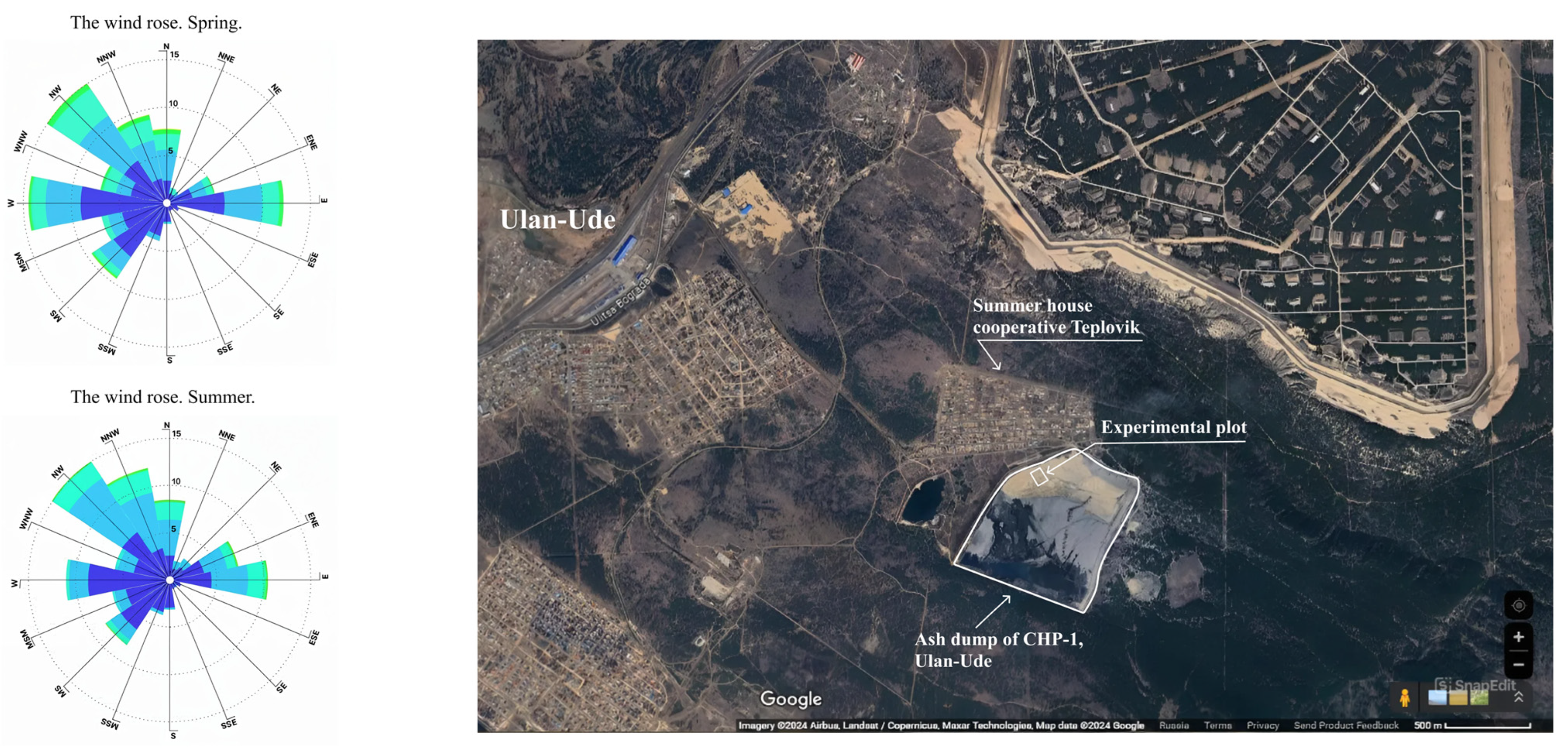


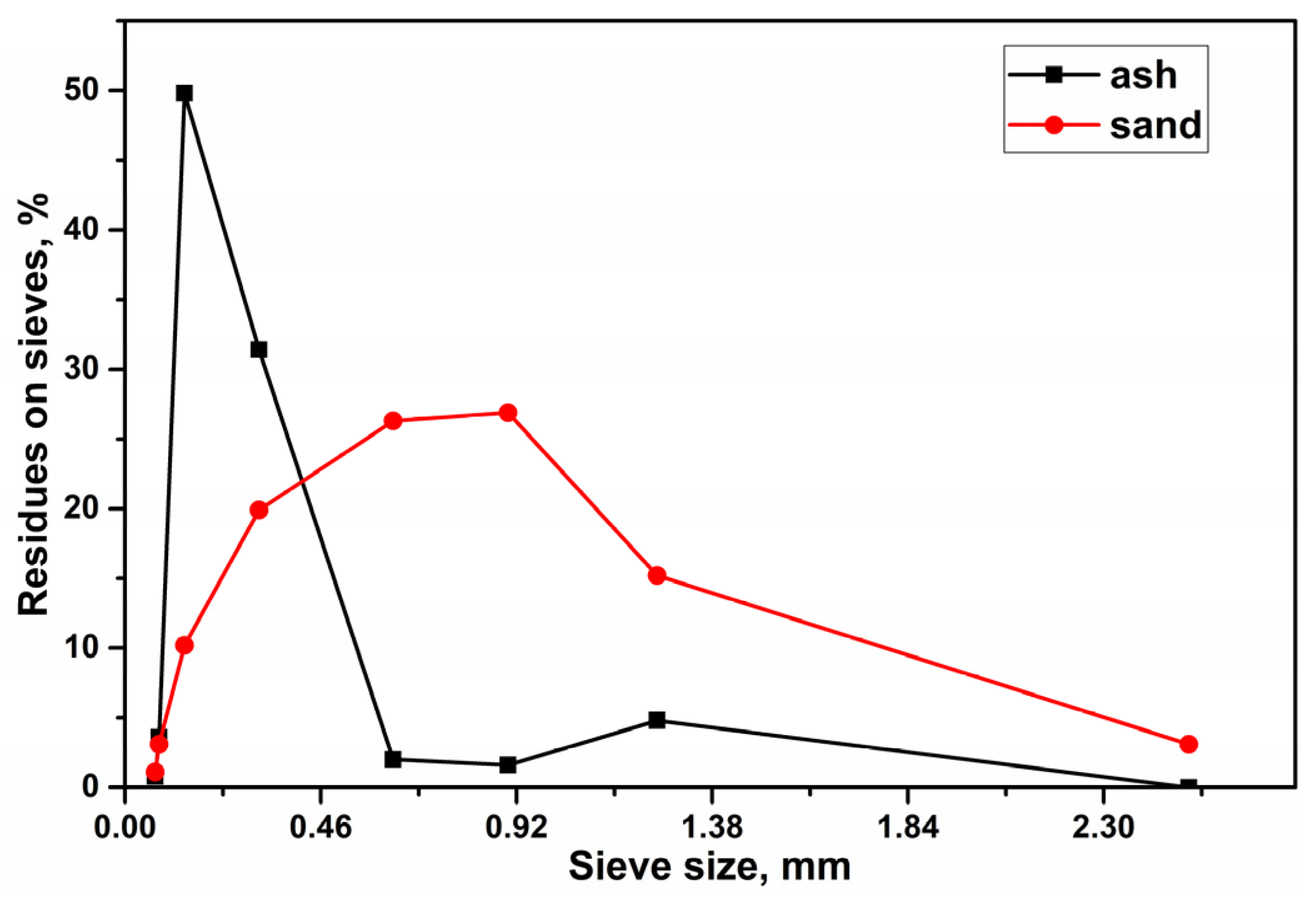
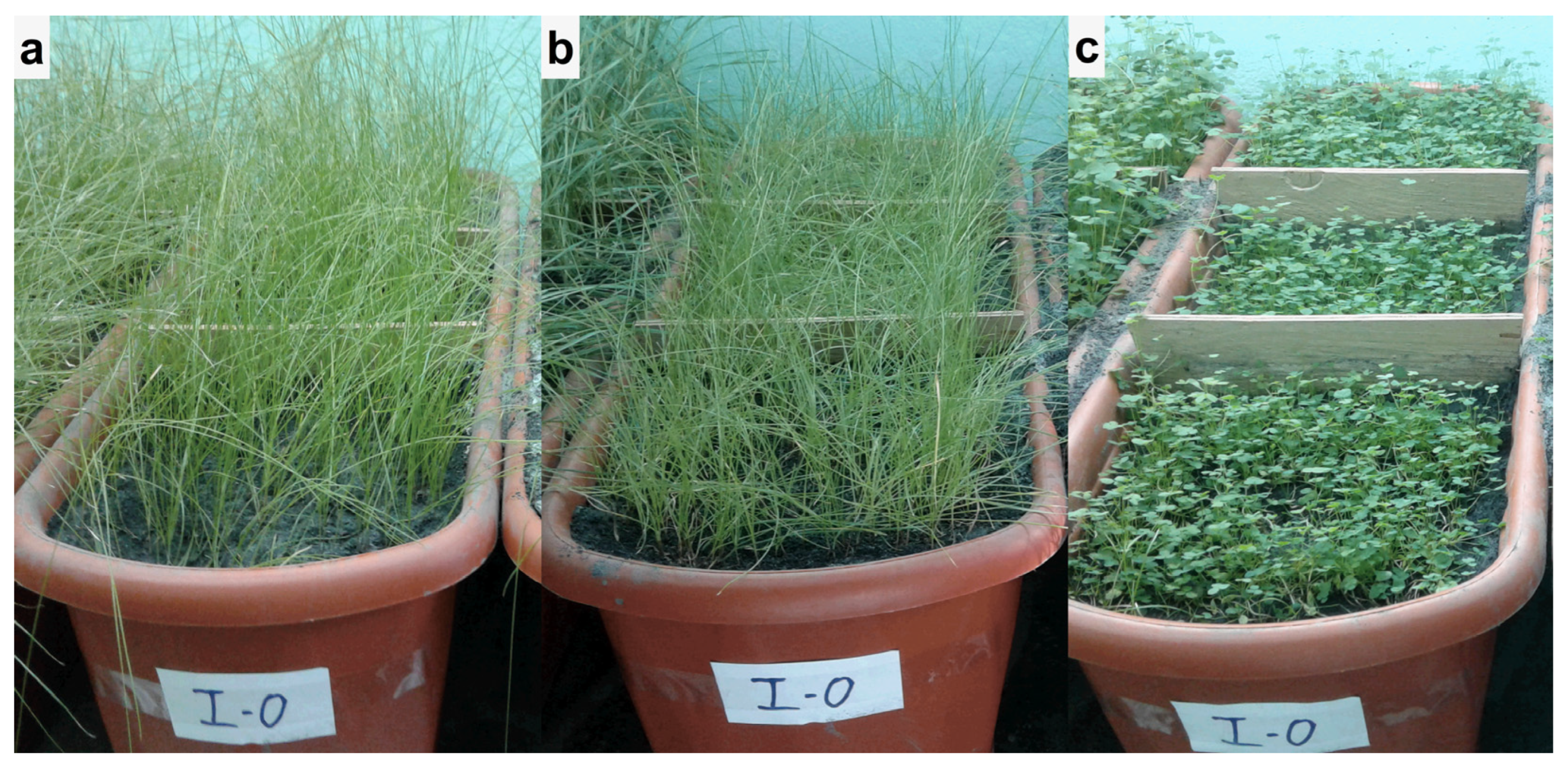
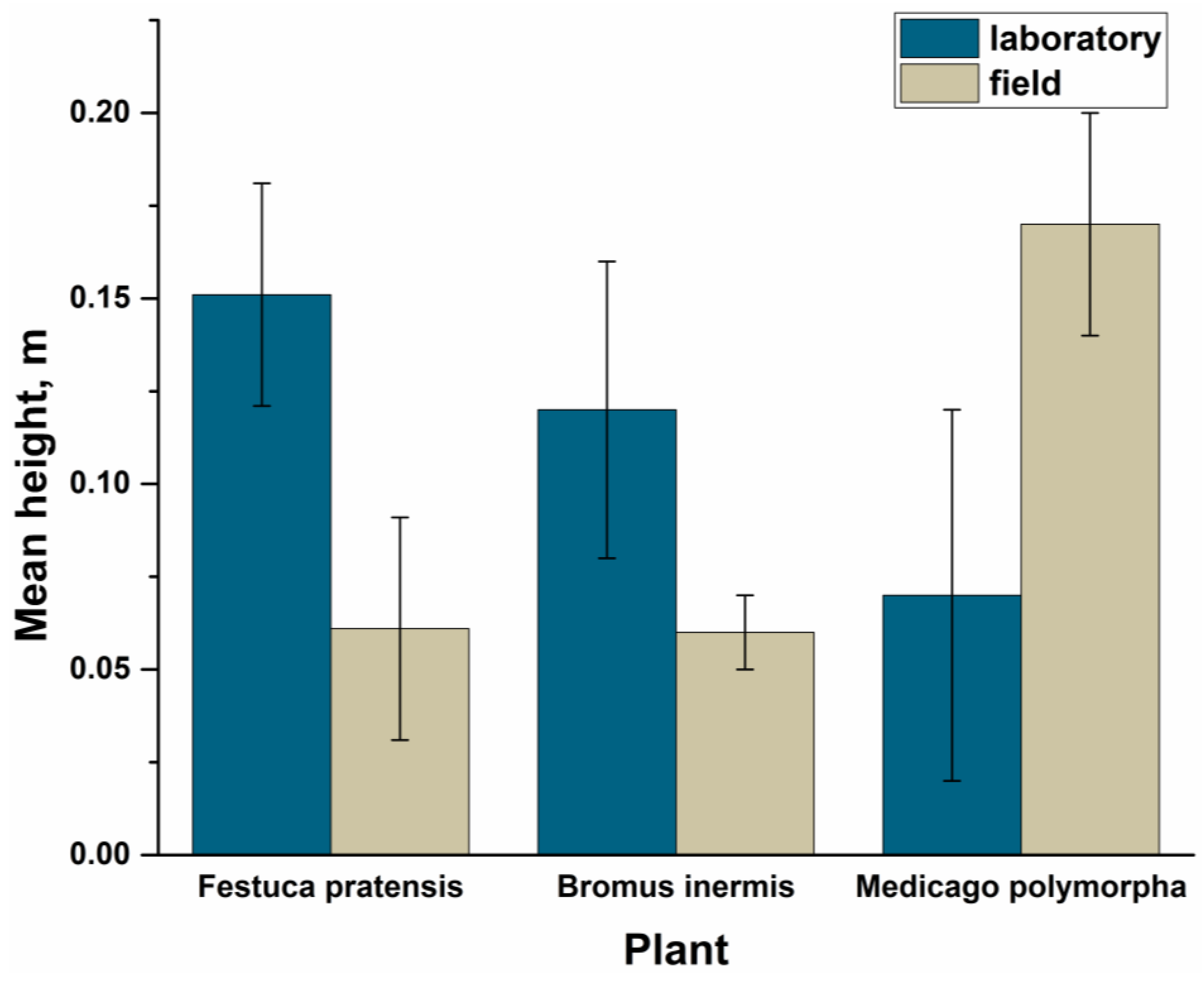
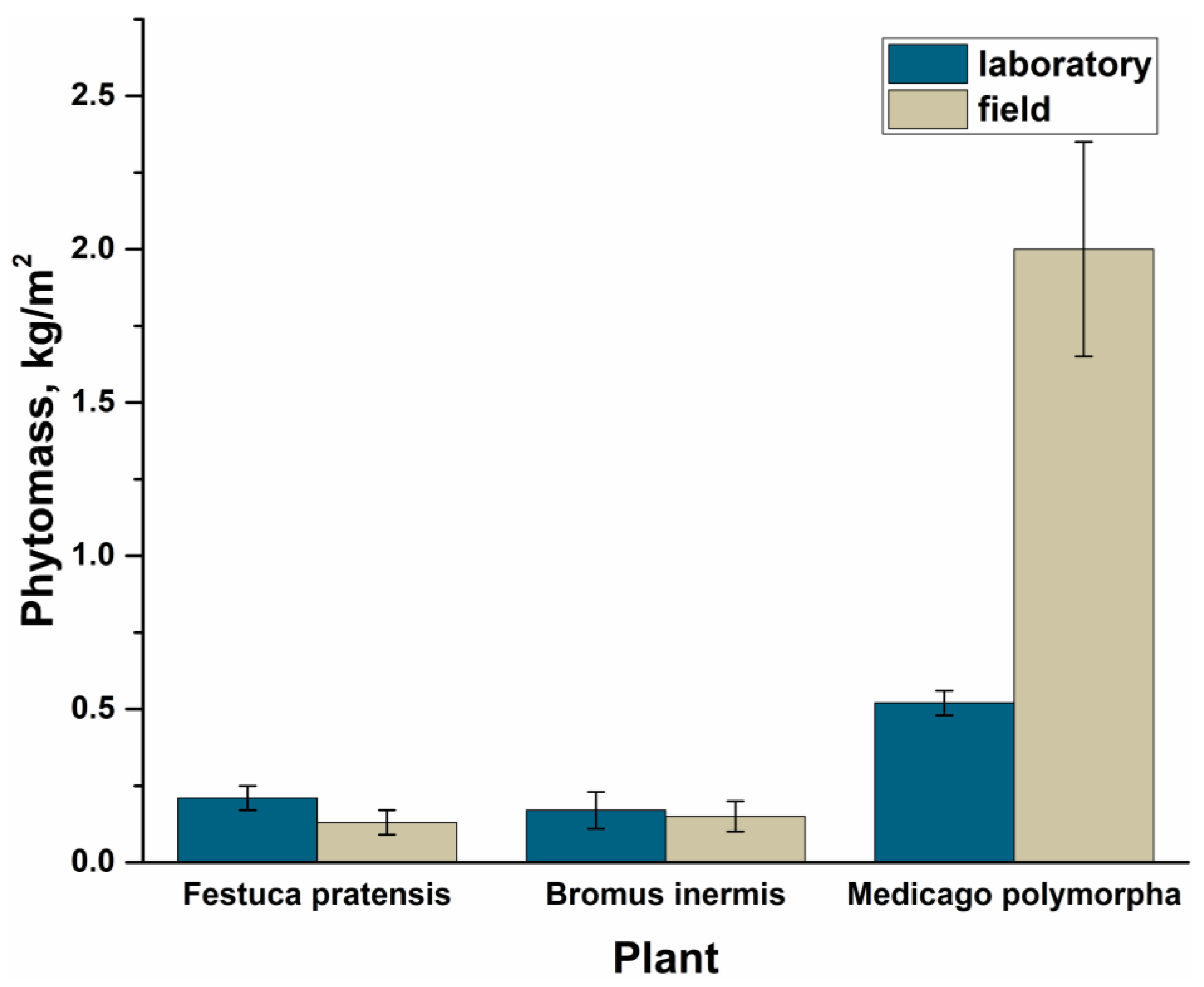

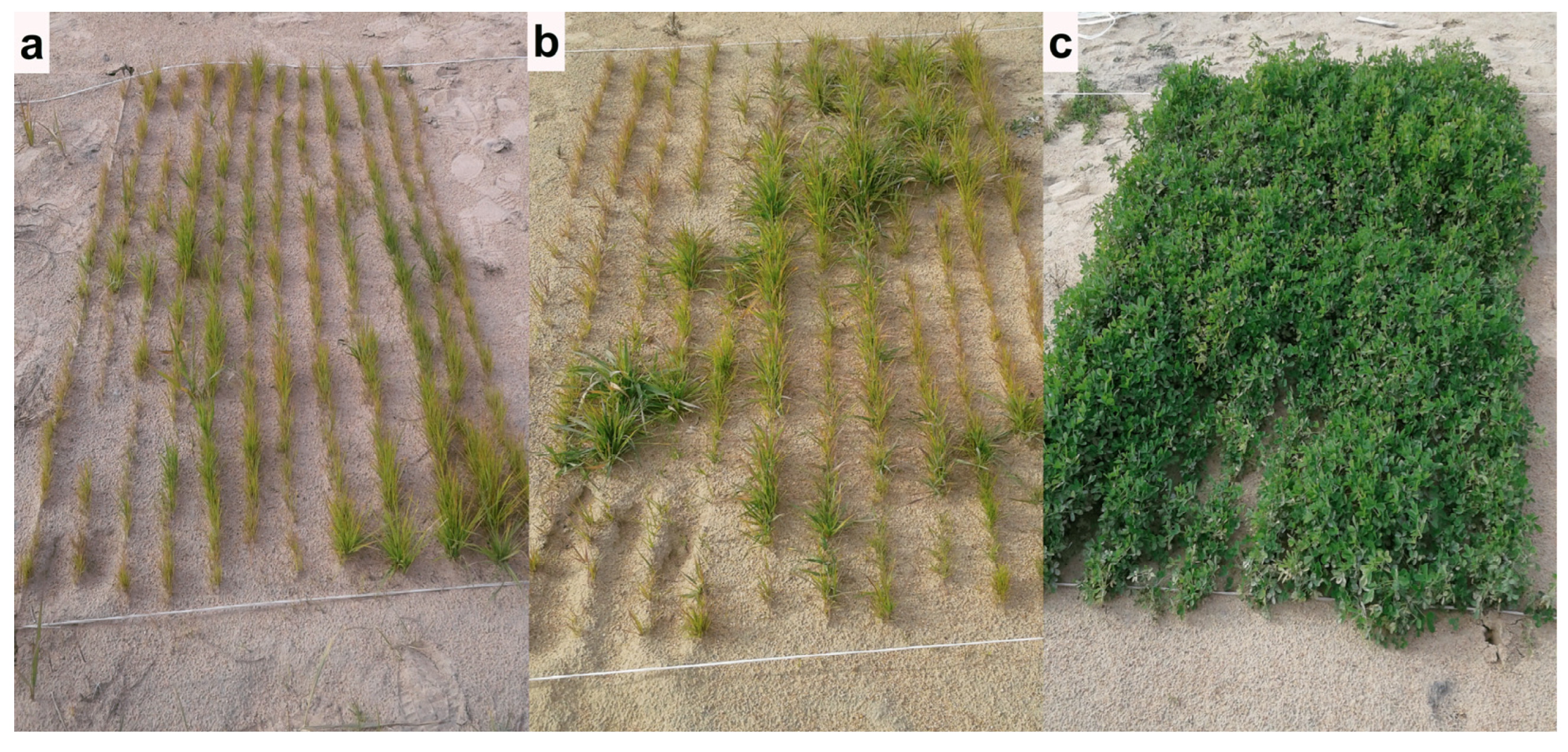
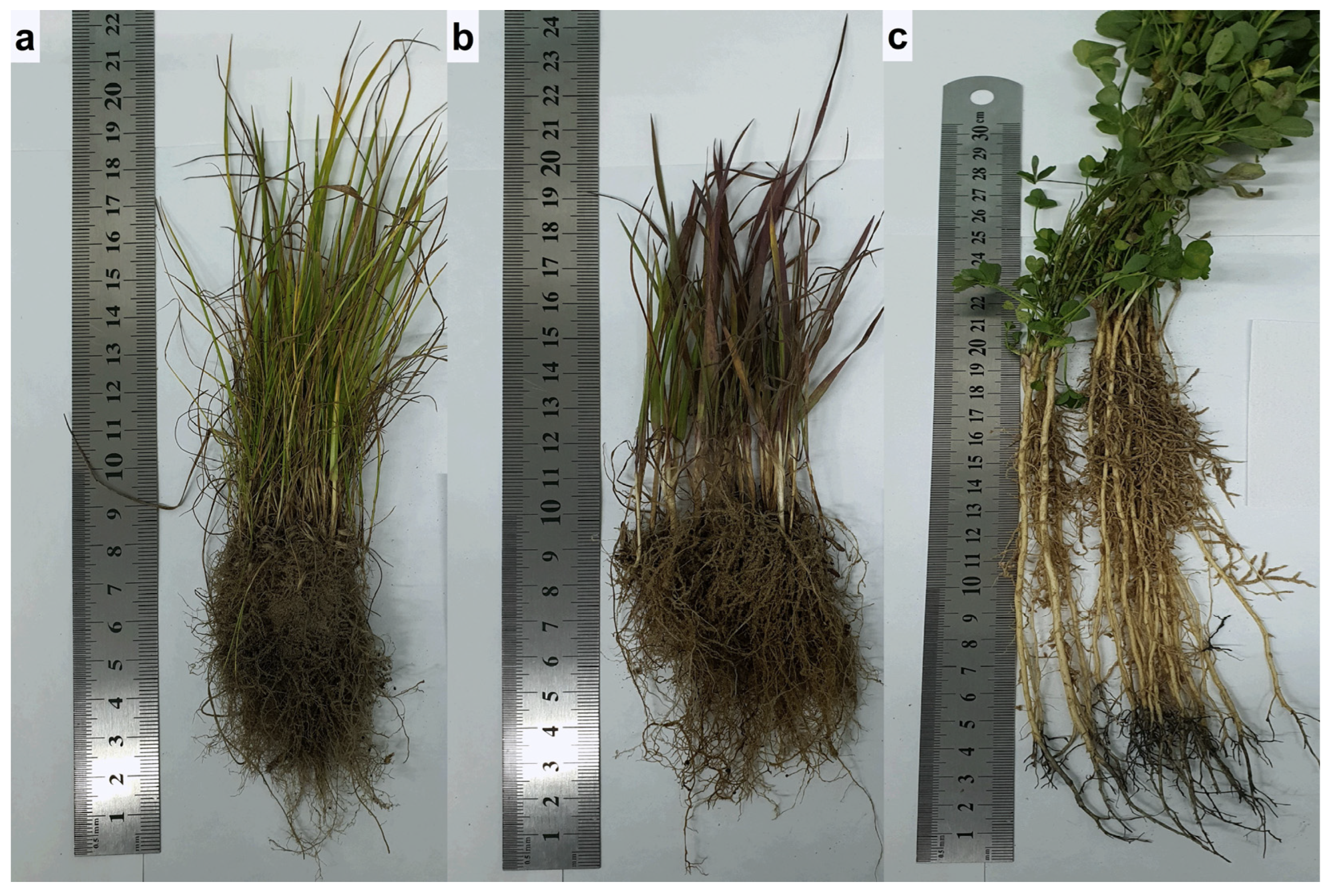
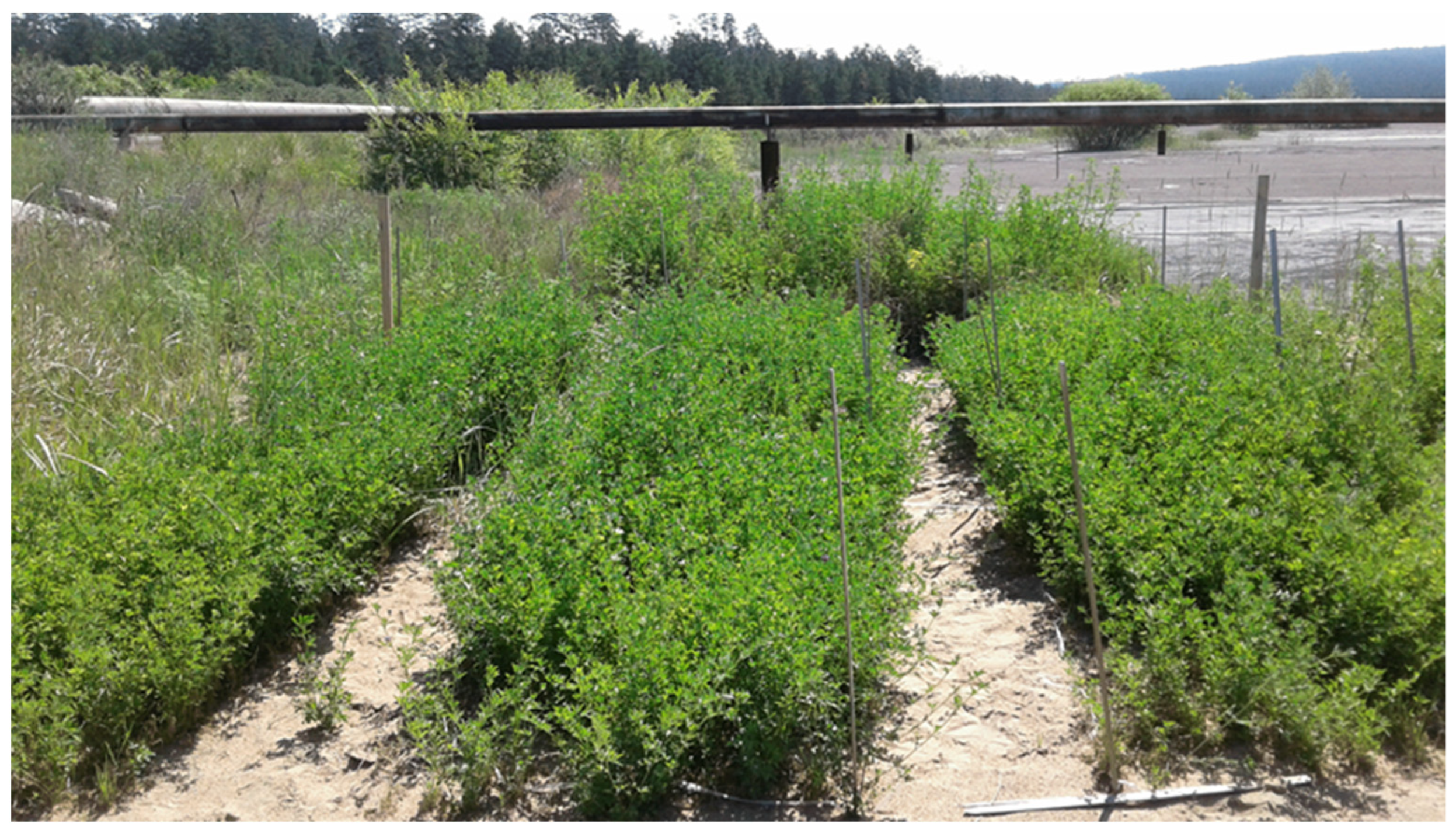
| Crop/Variety | Supplier | Germination Rate, % | Purity, % |
|---|---|---|---|
| Festuca pratensis/ “Sverdlovskaya—37” | “Agrozashchita”, LLC (Oryol, Russia) | 85.0 | 96.6 |
| Bromus inermis/ “Sibniiskhoz—189” | 76.0 | 92.1 | |
| Medicago polymorpha/ “Nakhodka” | 90.0 | 98.0 |
| Plant Species | Parameter (Mean Value) | |||||
|---|---|---|---|---|---|---|
| Height, m | Root Length, m | Phytomass, kg/m2 | ||||
| Laboratory | Field | Laboratory | Field | Laboratory | Field | |
| Festuca pratensis | 0.15 ± 0.03 | 0.06 ± 0.03 | 0.10 ± 0.02 | 0.08 ± 0.01 | 0.21 ± 0.04 | 0.13 ± 0.04 |
| Bromus inermis | 0.12 ± 0.04 | 0.06 ± 0.01 | 0.10 ± 0.02 | 0.08 ± 0.01 | 0.17 ± 0.06 | 0.15 ± 0.05 |
| Medicago polymorpha | 0.07 ± 0.05 | 0.17 ± 0.03 | 0.08 ± 0.01 | 0.20 ± 0.01 | 0.52 ± 0.04 | 2.00 ± 0.35 |
Disclaimer/Publisher’s Note: The statements, opinions and data contained in all publications are solely those of the individual author(s) and contributor(s) and not of MDPI and/or the editor(s). MDPI and/or the editor(s) disclaim responsibility for any injury to people or property resulting from any ideas, methods, instructions or products referred to in the content. |
© 2025 by the authors. Licensee MDPI, Basel, Switzerland. This article is an open access article distributed under the terms and conditions of the Creative Commons Attribution (CC BY) license (https://creativecommons.org/licenses/by/4.0/).
Share and Cite
Khudyakova, L.I.; Garkusheva, N.M.; Paleev, P.L.; Kotova, I.Y.; Khomoksonova, D.P.; Gulyashinov, P.A.; Antropova, I.G. Revegetation of Thermal Power Plant Ash Dumps or Sustainable Urban Development. Urban Sci. 2025, 9, 210. https://doi.org/10.3390/urbansci9060210
Khudyakova LI, Garkusheva NM, Paleev PL, Kotova IY, Khomoksonova DP, Gulyashinov PA, Antropova IG. Revegetation of Thermal Power Plant Ash Dumps or Sustainable Urban Development. Urban Science. 2025; 9(6):210. https://doi.org/10.3390/urbansci9060210
Chicago/Turabian StyleKhudyakova, Lyudmila Ivanovna, Natalya Mikhailovna Garkusheva, Pavel Leonidovich Paleev, Irina Yurievna Kotova, Darya Petrovna Khomoksonova, Pavel Anatolyevich Gulyashinov, and Inna Germanovna Antropova. 2025. "Revegetation of Thermal Power Plant Ash Dumps or Sustainable Urban Development" Urban Science 9, no. 6: 210. https://doi.org/10.3390/urbansci9060210
APA StyleKhudyakova, L. I., Garkusheva, N. M., Paleev, P. L., Kotova, I. Y., Khomoksonova, D. P., Gulyashinov, P. A., & Antropova, I. G. (2025). Revegetation of Thermal Power Plant Ash Dumps or Sustainable Urban Development. Urban Science, 9(6), 210. https://doi.org/10.3390/urbansci9060210






